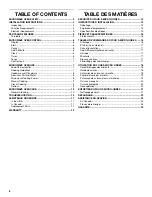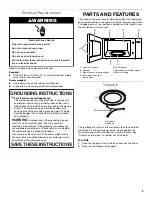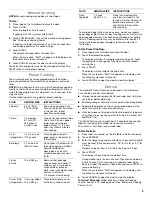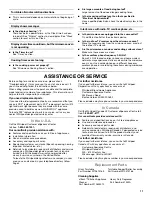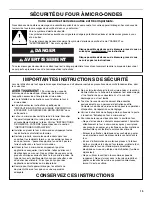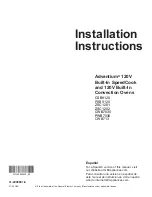
7
Tones
Tones are audible signals that can be turned off.
To Turn Off/On All Tones: Touch and hold POWER LEVEL for
5 seconds, until “Off” appears in the display. Repeat to turn tones
back on (“On” will appear in the display).
These tones indicate the following:
One tone
■
Valid entry
■
End of Timer (long tone)
Two tones
■
End of stage in multistage cooking
■
Control Lock active (short tones)
Three tones
■
End of cycle
Five tones
■
During Defrost cycle, reminder to check, turn, rearrange, or
separate food
Control Lock
The Control Lock disables the control panel pads to avoid
unintended use of the microwave oven.
To Lock/Unlock Control: The microwave oven must be off.
Touch and hold CANCEL for 5 seconds until the tones sound and
the LOCK icon and “LoC” appear in the display. Repeat to unlock
and clear the display (2 tones will sound).
If any cook function control is touched while the Control Lock is
active, “LoC” will appear briefly in the display and 2 tones will
sound.
MICROWAVE OVEN USE
A magnetron in the microwave oven produces microwaves which
reflect off the metal floor, walls and ceiling and pass through the
turntable and appropriate cookware to the food. Microwaves are
attracted to and absorbed by fat, sugar and water molecules in
the food, causing them to move, producing friction and heat
which cooks the food.
■
To avoid damage to the microwave oven, do not lean on or
allow children to swing on the microwave oven door.
■
To avoid damage to the microwave oven, do not operate
microwave oven when it is empty.
■
Baby bottles and baby food jars should not be heated in
microwave oven.
■
Clothes, flowers, fruit, herbs, wood, gourds, paper, including
brown paper bags and newspaper, should not be dried in
microwave oven.
■
Paraffin wax will not melt in the microwave oven because it
does not absorb microwaves.
■
Use oven mitts or pot holders when removing containers from
microwave oven.
■
Do not overcook potatoes. At the end of the recommended
cook time, potatoes should be slightly firm. Let potatoes
stand for 5 minutes. They will finish cooking while standing.
■
Do not cook or reheat whole eggs inside the shell. Steam
buildup in whole eggs may cause them to burst, requiring
significant cleanup of microwave oven cavity. Cover poached
eggs and allow a standing time.
Food Characteristics
When microwave cooking, the amount, size and shape, starting
temperature, composition and density of the food affect cooking
results.
Amount of Food
The more food heated at once, the longer the cook time needed.
Check for doneness and add small increments of time if
necessary.
Size and Shape
Smaller pieces of food will cook more quickly than larger pieces,
and uniformly shaped foods cook more evenly than irregularly
shaped food.
Starting Temperature
Room temperature foods will heat faster than refrigerated foods,
and refrigerated foods will heat faster than frozen foods.
Composition and Density
Foods high in fat and sugar will reach a higher temperature, and
will heat faster than other foods. Heavy, dense foods, such as
meat and potatoes, require a longer cook time than the same size
of a light, porous food, such as cake.
Cooking Guidelines
Covering
Covering food helps retain moisture, shorten cook time and
reduce spattering. Use the lid supplied with cookware. If a lid is
not available, wax paper, paper towels or plastic wrap approved
for microwave ovens may be used. Plastic wrap should be turned
back at one corner to provide an opening to vent steam.
Condensation on the door and cavity surfaces is normal during
heavy cooking.
Stirring and Turning
Stirring and turning redistribute heat evenly to avoid overcooking
the outer edges of food. Stir from outside to center. If possible,
turn food over from bottom to top.
Arranging
If heating irregularly shaped or different sized foods, arrange the
thinner parts and smaller sized items toward the center. If
cooking several items of the same size and shape, place them in
a ring pattern, leaving the center of the ring empty.
Piercing
Before heating, use a fork or small knife to pierce or prick foods
that have a skin or membrane, such as potatoes, egg yolks,
chicken livers, hot dogs, and sausage. Prick in several places to
allow steam to vent.
Shielding
Use small, flat pieces of aluminum foil to shield the thin pieces of
irregularly shaped foods, bones and foods such as chicken
wings, leg tips and fish tail. See “Aluminum Foil and Metal” first.
Standing Time
Food will continue to cook by the natural conduction of heat even
after the microwave cooking cycle ends. The length of standing
time depends on the volume and density of the food.


